New Zealand takes my breath away. Each place I visit is more beautiful than the last. Yesterday morning I left Queenstown on the InterCity bus, bound for the South Island’s remote west coast town of Franz Josef to hike its amazing glacier. The west coast of New Zealand is the country’s last frontier. Although there is an airport at Franz Josef it provides only flightseeing over the glacier or charter service, so the only access to this part of the country is by car or bus.
Let me digress for a moment to say that the bus service in New Zealand is nothing short of spectacular. I have purchased a 20-hour FlexiPass that combines bus service from three companies (InterCity, Newmans and Northland). With a day’s notice I can phone toll-free to reserve a seat on any scheduled bus and the hours required to reach the destination are automatically deducted from my pass. When I run out of hours I can phone them up to “top off the pass,” using my credit card to add more hours. It can even be used on the ferry running between Wellington on the North Island and Picton on the South Island. The cost for 20 hours was $214 New Zealand (about $160 US) and with the exception of my flight from Auckland to Queenstown, I have used it to get to all my destinations.
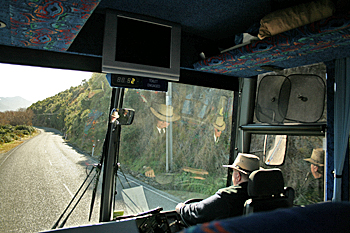
Riding the bus here is nothing like taking a bus in the US. The coaches have comfortable reclining seats, footrests, and huge expanses of sparkling clean windows that are perfect for viewing the spectacular vistas revealed around every corner. Incredibly, the bus drivers (keep in mind that these are regularly scheduled inter-city buses – not tour buses) provide a running commentary along the way, entertaining the passengers with bits of history, local gossip, and explanations for what is passing by our windows. Regular stops are made at pullouts where the government has constructed restrooms that are maintained in a sparkling clean condition. These restrooms are always located at scenic overlooks or at trail heads, where a five or ten minute walk along a path takes you to, for instance, a stunning waterfall, and the bus stops long enough for everyone to take a quick jaunt down the path.
Frankly, I was glad to be leaving Queenstown. Although it is a beautiful city in a stunning location, unless you are into adventure sports there is not a lot to do there. Had I stayed longer my options would have been jet boating the Dart River (and being spun around 360 degrees in the rapids), bungee jumping from the top of the gondola mountain, riding the luge down the gondola mountain, skiing, heli-skiing (being dropped out of a helicopter onto a mountain top and skiing down), skydiving, or heli-biking (I don’t even want to THINK about what this might be). Plus, it is COLD there, so I was glad to finally be heading north again.
My route to the west coast traveled a narrow blacktop that snaked up and over the mountains running down the spine of the island, eventually dropping down onto the windswept coast. From Queenstown we traveled along a canyon formed by the Dart River and into the Wanaka Valley, which is rapidly being converted from farming into vineyards. (Note: when New Zealanders speak of farming they are referring to sheep, cattle and deer farming – very few crops are grown here in the traditional farming sense).
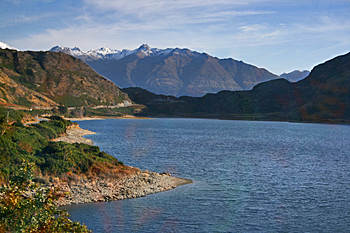
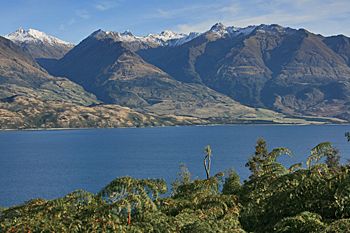
After passing through the town of Wanaka we began to climb, following the shores of Lake Wanaka and Lake Hawea, where snow-clad purple peaks peeked over the dun colored hills bordering the lakes’ indigo waters. As we entered the Upper Clutha Valley, expanses of pasture land added dimension to the palette, with flocks of fluffy white sheep and herds of deer dotting the verdant green fields at the foot of the mountains. We stopped briefly at a cafe in the tiny mountain village of Makarora, which is the gateway to Mount Aspiring National Park, and continued up the mountains to Haast Pass, where we began to get glimpses of the snow-bound Southern Alps.

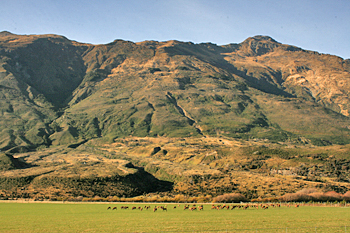
By the time we crossed over the continental divide the majestic Southern Alps were in full view. The bus dipped down into the narrow valley on the west side of the mountains, making brief stops for photos at Thunder Falls, Lake Paringa, Murphy’s Beach overlook, and Bruce’s Beach.

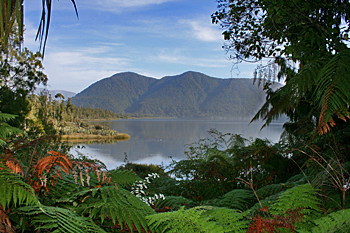
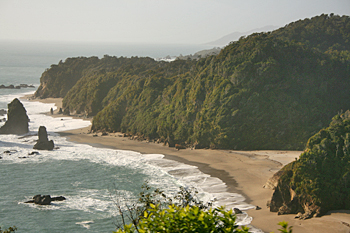
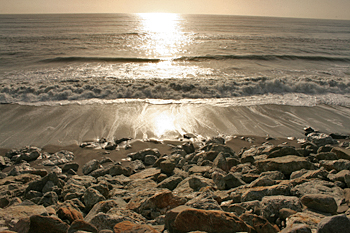
Roads into this part of New Zealand were only completed in the mid-1960s. Prior to that time west coast inhabitants were extremely isolated from civilization. Today, although there is a road, this part of the country is still remote. The nearest hospital is 4 hours to the north in Greymouth. Because a rock slide or avalanche can close the road for weeks at a time, no dairy farming is done south of Franz Josef, as tanker trucks refuse to service farms in this area due to the possibility of not being able to pick up the milk. As you can imagine, west coast folks are a hearty, self-sufficient lot. There are not a lot of women here and I have been warned to watch out because the men are always on the lookout for good wife material.
And not only the people are unique. With no more than 30 kilometers between the mountains and the sea, the west coast supports a unique sub-tropical micro-climate. A land of ice-cold rivers winding through rocky scree, their waters tinted turquoise or pale gray from ground up rock powder released in the glacial melt water. A land where miners still stake claims and pan for gold in the black sand river mouths, often earning more than a thousand dollars per month for their efforts. A land of deciduous forest, with huge pine trees towering over the giant ferns and the more than 300 varieties of moss that carpet the forest floor. A land of jagged schist and basalt cliffs and boulders scraped smooth by retreating glaciers. A land of glaciers, hundreds of feet thick and miles long, that are inexorably creeping from the mountaintop to the valley below on their journey to the sea. And, unexpectedly, a land of warm temperatures! I peeled off layer after layer when we arrived in Franz Josef.

I had time enough to walk the short main street of town and do a quick hike to the top of Sentinel Hill for my first view of the glacier before darkness fell. It was enough to satisfy my initial curiosity and to whet my appetite. Tomorrow I will hike to the foot of the glacier if the trail is open. I don’t think I have anything to worry about where wildlife is concerned (bears and such), but I will keep an eye peeled for the well-known and very dangerous wife-hunting west coaster.

What a compelling story! Matt of Backpacking Matt once lived on Franz Joseph – he’s got loads of anecdotes about it.
I loved New Zealand, Cat. I really have to go back – two weeks was not nearly enough.
Wonder who Murphy and Bruce were that there are beaches named after them. As usual, your pictures were just incredible. Take care and be well.
Barb, thanks for sharing your wonderful experiences…your photographs are just awesome!!